Munson B.R. Fundamentals of Fluid Mechanics
Подождите немного. Документ загружается.

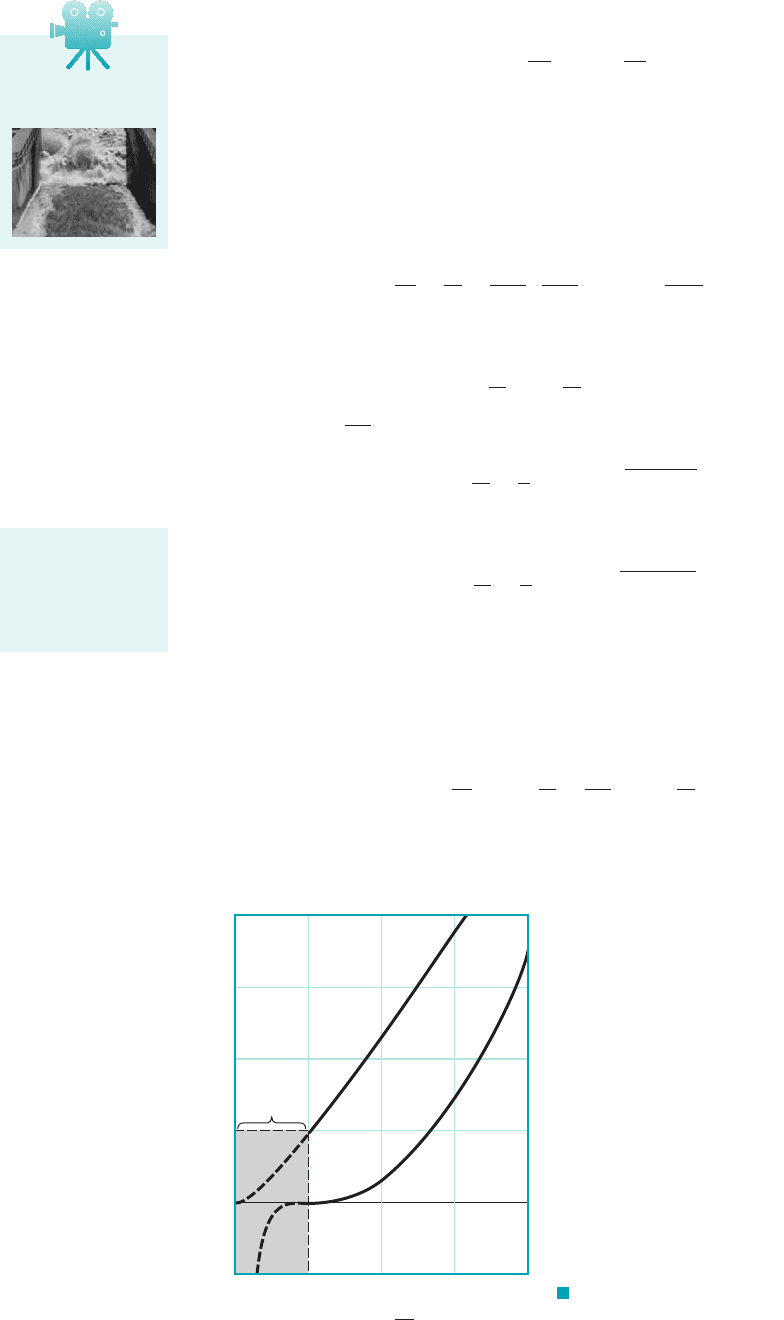
and the energy equation 1Eq. 5.842
(10.23)
The head loss, in Eq. 10.23 is due to the violent turbulent mixing and dissipation that occur
within the jump itself. We have neglected any head loss due to wall shear stresses.
Clearly Eqs. 10.21, 10.22, and 10.23 have a solution and This
represents the trivial case of no jump. Since these are nonlinear equations, it may be possible that
more than one solution exists. The other solutions can be obtained as follows. By combining Eqs.
10.21 and 10.22 to eliminate we obtain
which can be simplified by factoring out a common nonzero factor from each side to give
where is the upstream Froude number. By using the quadratic formula we obtain
Clearly the solution with the minus sign is not possible 1it would give a negative 2. Thus,
(10.24)
This depth ratio, across the hydraulic jump is shown as a function of the upstream Froude number
in Fig. 10.16. The portion of the curve for is dashed in recognition of the fact that to have a
hydraulic jump the flow must be supercritical. That is, the solution as given by Eq. 10.24 must be
restricted to for which This can be shown by consideration of the energy equation,
Eq. 10.23, as follows. The dimensionless head loss, can be obtained from Eq. 10.23 as
(10.25)
where, for given values of the values of are obtained from Eq. 10.24. As is indicated in
Fig. 10.16, the head loss is negative if Since negative head losses violate the second lawFr
1
6 1.
y
2
y
1
Fr
1
,
h
L
y
1
1
y
2
y
1
Fr
1
2
2
c1 a
y
1
y
2
b
2
d
h
L
y
1
,
y
2
y
1
1.Fr
1
1,
Fr
1
6 1
y
2
y
1
,
y
2
y
1
1
2
11 21 8Fr
1
2
2
y
2
y
1
y
2
y
1
1
2
11 21 8Fr
1
2
2
Fr
1
V
1
1gy
1
a
y
2
y
1
b
2
a
y
2
y
1
b 2 Fr
1
2
0
y
1
y
2
y
1
2
2
y
2
2
2
V
1
y
1
g
a
V
1
y
1
y
2
V
1
b
V
2
1
y
1
gy
2
1y
1
y
2
2
V
2
h
L
0.y
1
y
2
, V
1
V
2
,
h
L
,
y
1
V
2
1
2g
y
2
V
2
2
2g
h
L
10.6 Rapidly Varied Flow 557
The depth ratio
across a hydraulic
jump depends on
the Froude number
only.
F I G U R E 10.16 Depth ratio and dimension-
less head loss across a hydraulic jump as a function of
upstream Froude number.
4
3
2
1
0
–1
01 2 34
No jump
possible
Fr
1
=
V
1
______
√
gy
1
y
2
_
_
y
1
y
2
__
y
1
h
L
__
y
1
h
L
_
_
y
1
or
V10.11 Hydraulic
jump in a river
JWCL068_ch10_534-578.qxd 9/23/08 11:54 AM Page 557

of thermodynamics 1viscous effects dissipate energy, they cannot create energy; see Section 5.32,
it is not possible to produce a hydraulic jump with The head loss across the jump is
indicated by the lowering of the energy line shown in Fig. 10.15.
A flow must be supercritical 1Froude number 2to produce the discontinuity called a
hydraulic jump. This is analogous to the compressible flow ideas discussed in Chapter 11 in which
it is shown that the flow of a gas must be supersonic 1Mach number 2to produce the
discontinuity called a normal shock wave. However, the fact that a flow is supercritical 1or
supersonic2does not guarantee the production of a hydraulic jump 1or shock wave2. The trivial
solution and is also possible.
The fact that there is an energy loss across a hydraulic jump is useful in many situations. For
example, the relatively large amount of energy contained in the fluid flowing down the spillway
of a dam like that shown in the figure in the margin could cause damage to the channel below the
dam. By placing suitable flow control objects in the channel downstream of the spillway, it is
possible 1if the flow is supercritical2to produce a hydraulic jump on the apron of the spillway and
thereby dissipate a considerable portion of the energy of the flow. That is, the dam spillway produces
supercritical flow, and the channel downstream of the dam requires subcritical flow. The resulting
hydraulic jump provides the means to change the character of the flow.
V
1
V
2
y
1
y
2
7 1
7 1
Fr
1
6 1.
558 Chapter 10 ■ Open-Channel Flow
Hydraulic jumps
dissipate energy.
Fluids in the News
Grand Canyon rapids buildingVirtually all of the rapids in the
Grand Canyon were formed by rock debris carried into the Col-
orado River from side canyons. Severe storms wash large
amounts of sediment into the river, building debris fans that nar-
row the river. This debris forms crude dams which back up the
river to form quiet pools above the rapids. Water exiting the pool
through the narrowed channel can reach supercritical conditions
and produce hydraulic jumps downstream. Since the configura-
tion of the jumps is a function of the flowrate, the difficulty in
running the rapids can change from day to day. Also, rapids
change over the years as debris is added to or removed from the
rapids. For example, Crystal Rapid, one of the notorious rafting
stretches of the river, changed very little between the first photos
of 1890 and those of 1966. However, a debris flow from a severe
winter storm in 1966 greatly constricted the river. Within a few
minutes the configuration of Crystal Rapid was completely
changed. The new, immature rapid was again drastically changed
by a flood in 1983. While Crystal Rapid is now considered full
grown, it will undoubtedly change again, perhaps in 100 or 1000
years. (See Problem 10.100.)
GIVEN Water on the horizontal apron of the 100-ft-wide spill-
way shown in Fig. E10.7a has a depth of 0.60 ft and a velocity of
18 ft兾s.
Hydraulic Jump
E
XAMPLE 10.7
S
OLUTION
Conditions across the jump are determined by the upstream
Froude number
(Ans)
Thus, the upstream flow is supercritical, and it is possible to gen-
erate a hydraulic jump as sketched.
From Eq. 10.24 we obtain the depth ratio across the jump as
1
2
31 21 814.102
2
4 5.32
y
2
y
1
1
2
11 21 8 Fr
2
1
2
Fr
1
V
1
1gy
1
18 ft
s
3132.2 ft
s
2
210.60 ft24
1
2
4.10
or
(Ans)
Since or
it follows that
(Ans)
As is true for any hydraulic jump, the flow changes from super-
critical to subcritical flow across the jump.
The power 1energy per unit time2dissipated, by viscous
effects within the jump can be determined from the head loss
p
d
,
Fr
2
V
2
2gy
2
3.39 ft
s
3132.2 ft
s
2
213.19 ft24
1
2
0.334
3.39 ft
s,
V
2
1y
1
V
1
2
y
2
0.60 ft 118 ft
s2
3.19 ft Q
1
Q
2
,
y
2
5.32 10.60 ft2 3.19 ft
FIND Determine the depth, after the jump, the Froude
numbers before and after the jump, and and the power dis-
sipated, within the jump.
p
d
,
Fr
2
,
Fr
1
y
2
,
(Photograph courtesy
of U.S. Army Corps
of Engineers.)
JWCL068_ch10_534-578.qxd 9/23/08 11:54 AM Page 558
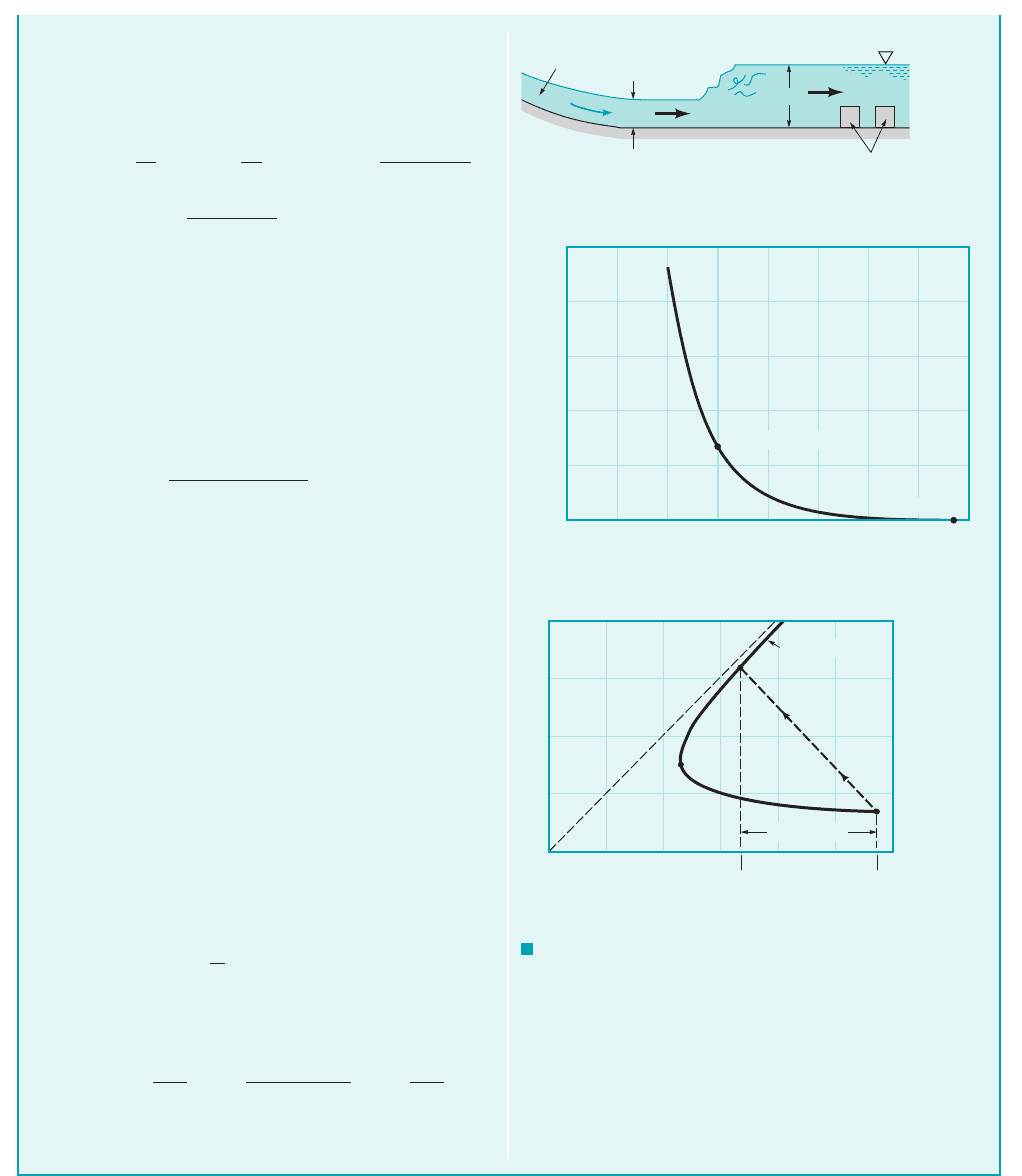
The actual structure of a hydraulic jump is a complex function of even though the depth
ratio and head loss are given quite accurately by a simple one-dimensional flow analysis 1Eqs. 10.24
and 10.252. A detailed investigation of the flow indicates that there are essentially five types of
surface and jump conditions. The classification of these jumps is indicated in Table 10.2, along with
sketches of the structure of the jump. For flows that are barely supercritical, the jump is more like
a standing wave, without a nearly step change in depth. In some Froude number ranges the jump is
Fr
1
,
10.6 Rapidly Varied Flow 559
as 1see Eq. 5.852
(12
where is obtained from Eqs. 10.23 or 10.25 as
or
Thus, from Eq. 1,
or
(Ans)
COMMENTS This power, which is dissipated within the
highly turbulent motion of the jump, is converted into an increase
in water temperature, T. That is, Although the power
dissipated is considerable, the difference in temperature is not
great because the flowrate is quite large.
By repeating the calculations for the given flowrate Q
1
⫽
but with
various upstream depths, y
1
, the results shown in Fig. E10.7b are
obtained. Note that a slight change in water depth can produce a
considerable change in energy dissipated. Also, if
the flow is subcritical ( ) and no hydraulic jump can occur.
The hydraulic jump flow process can be illustrated by use of the
specific energy concept introduced in Section 10.3 as follows. Equa-
tion 10.23 can be written in terms of the specific energy,
as where
and As is discussed in
Section 10.3, the specific energy diagram for this flow can be ob-
tained by using where
Thus,
where y and E are in feet. The resulting specific energy diagram
is shown in Fig. E10.7c. Because of the head loss across the
E ⫽ y ⫹
q
2
2gy
2
⫽ y ⫹
110.8 ft
2
Ⲑ
s2
2
2132.2 ft
Ⲑ
s
2
2y
2
⫽ y ⫹
1.81
y
2
⫽ 10.8 ft
2
Ⲑ
s
q ⫽ q
1
⫽ q
2
⫽
Q
b
⫽ y
1
V
1
⫽ 0.60 ft 118.0 ft
Ⲑ
s2
V ⫽ q
Ⲑ
y,
E
2
⫽ y
2
⫹ V
2
2
Ⲑ
2g ⫽ 3.37 ft.5.63 ft
E
1
⫽ y
1
⫹ V
1
2
Ⲑ
2g ⫽E
1
⫽ E
2
⫹ h
L
,E ⫽ y ⫹ V
2
Ⲑ
2g,
Fr
1
6 1
y
1
7 1.54 ft
A
1
V
1
⫽ b
1
y
1
V
1
⫽ 100 ft 10.6 ft2118 ft
Ⲑ
s2⫽ 1080 ft
3
Ⲑ
s
T
2
7 T
1
.
p
d
⫽
1.52 ⫻ 10
5
ft
#
lb
Ⲑ
s
55031ft
#
lb
Ⲑ
s2
Ⲑ
hp4
⫽ 277 hp
⫽ 1.52 ⫻ 10
5
ft
#
lb
Ⲑ
s
p
d
⫽ 162.4 lb
Ⲑ
ft
3
21100 ft210.60 ft2118.0 ft
Ⲑ
s212.26 ft2
h
L
⫽ 2.26 ft
⫺ c3.19 ft ⫹
13.39 ft
Ⲑ
s2
2
2132.2 ft
Ⲑ
s
2
2
d
h
L
⫽ ay
1
⫹
V
2
1
2g
b⫺ ay
2
⫹
V
2
2
2g
b⫽ c0.60 ft ⫹
118.0 ft
Ⲑ
s2
2
2132.2 ft
Ⲑ
s
2
2
d
h
L
p
d
⫽ gQh
L
⫽ gby
1
V
1
h
L
jump, the upstream and downstream values of E are different.
In going from state 112to state 122the fluid does not proceed
along the specific energy curve and pass through the critical
condition at state Rather, it jumps from 112to 122as is repre-
sented by the dashed line in the figure. From a one-dimensional
consideration, the jump is a discontinuity. In actuality, the jump
is a complex three-dimensional flow incapable of being repre-
sented on the one-dimensional specific energy diagram.
2¿.
(0.60 ft, 277 hp)
(1.54 ft, 0 hp)
1000
800
600
400
200
0
0 0.2 0.4 0.6 0.8
y
1
, ft
ᏼ
d
, hp
1 1.2 1.4 1.6
(
b)
F I G U R E E10.7
q = 10.8 ft
2
/s
(2)
(2
')
(1)
h
L
= 2.26 ft
4
3
2
1
0
0123456
y, ft
E, ft
E
2
= 3.37 E
1
= 5.63
(c)
y
1
= 0.60 ft
Downstream
obstacles
b = width = 100 ft
Spillway apron
V
1
= 18 ft/s
y
2
V
2
(a)
JWCL068_ch10_534-578.qxd 9/30/08 8:33 AM Page 559
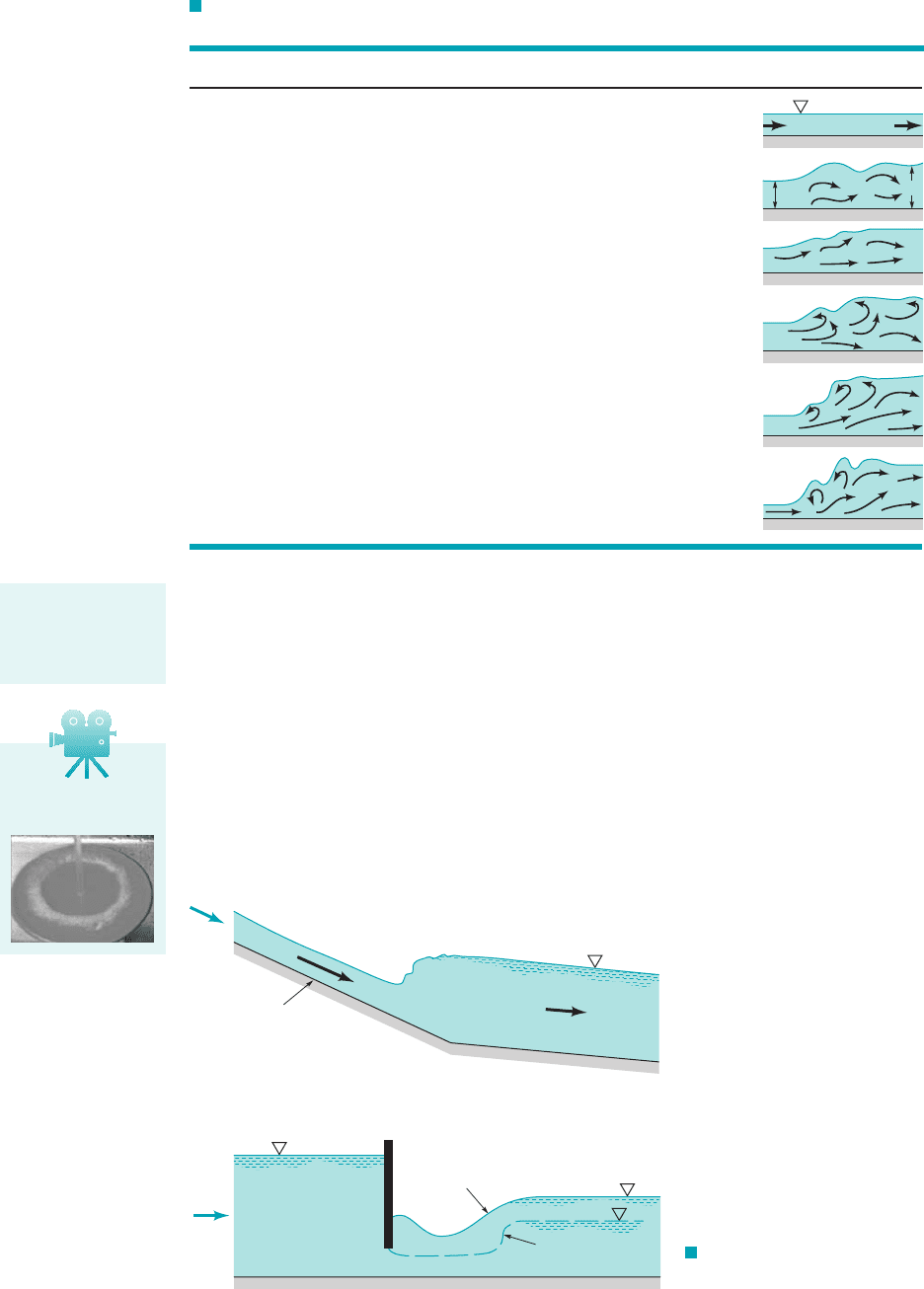
unsteady, with regular periodic oscillations traveling downstream. 1Recall that the wave cannot travel
upstream against the supercritical flow.2
The length of a hydraulic jump 1the distance between the nearly uniform upstream and
downstream flows2may be of importance in the design of channels. Although its value cannot be
determined theoretically, experimental results indicate that over a wide range of Froude numbers,
the jump is approximately seven downstream depths long 1Ref. 52.
Hydraulic jumps can occur in a variety of channel flow configurations, not just in horizontal,
rectangular channels as discussed above. Jumps in nonrectangular channels 1i.e., circular pipes,
trapezoidal canals2behave in a manner quite like those in rectangular channels, although the details
of the depth ratio and head loss are somewhat different from jumps in rectangular channels.
Other common types of hydraulic jumps include those that occur in sloping channels as is
indicated in Fig. 10.17a and the submerged hydraulic jumps that can occur just downstream of a
560 Chapter 10 ■ Open-Channel Flow
TABLE 10.2
Classification of Hydraulic Jumps (Ref. 12)
Classification Sketch
1 Jump impossible
1 to 1.7 1 to 2.0 Standing wave or undulant jump
1.7 to 2.5 2.0 to 3.1 Weak jump
2.5 to 4.5 3.1 to 5.9 Oscillating jump
4.5 to 9.0 5.9 to 12 Stable, well-balanced steady jump;
insensitive to downstream conditions
Rough, somewhat intermittent strong jump71279.0
61
y
2
Ⲑ
y
1
Fr
1
V
1
y
1
V
2
= V
1
y
2
The actual struc-
ture of a hydraulic
jump depends on
the Froude number.
V10.12 Hydraulic
jump in a sink
F I G U R E 10.17
Hydraulic jump variations: (a) jump
caused by a change in channel slope,
(b) submerged jump.
V
2
V
1
S
0
< S
0c
S
0
> S
0c
(a)
Submerged jump
(
b)
Q
Q
Free jump
JWCL068_ch10_534-578.qxd 9/23/08 11:54 AM Page 560
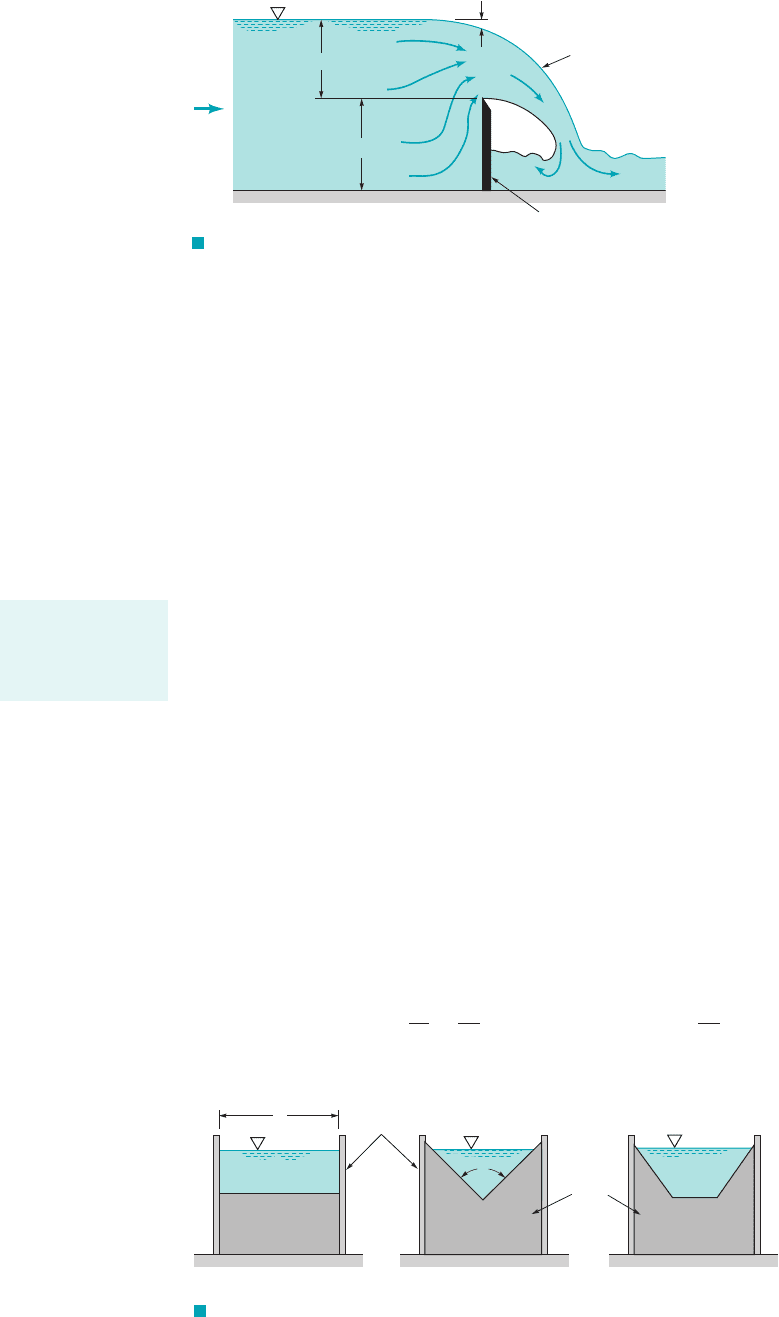
10.6 Rapidly Varied Flow 561
sluice gate as is indicated in Fig. 10.17b. Details of these and other jumps can be found in standard
open-channel flow references 1Refs. 3 and 52.
10.6.2 Sharp-Crested Weirs
A weir is an obstruction on a channel bottom over which the fluid must flow. It provides a convenient
method of determining the flowrate in an open channel in terms of a single depth measurement. A
sharp-crested weir is essentially a vertical sharp-edged flat plate placed across the channel in a way
such that the fluid must flow across the sharp edge and drop into the pool downstream of the weir
plate, as is shown in Fig. 10.18. The specific shape of the flow area in the plane of the weir plate
is used to designate the type of weir. Typical shapes include the rectangular weir, the triangular weir,
and the trapezoidal weir, as indicated in Fig. 10.19.
The complex nature of the flow over a weir makes it impossible to obtain precise analytical
expressions for the flow as a function of other parameters, such as the weir height, weir head,
H, the fluid depth upstream, and the geometry of the weir plate 1angle for triangular weirs or
aspect ratio, for rectangular weirs2. The flow structure is far from one-dimensional, with a
variety of interesting flow phenomena obtained.
The main mechanisms governing flow over a weir are gravity and inertia. From a highly
simplified point of view, gravity accelerates the fluid from its free-surface elevation upstream
of the weir to larger velocity as it flows down the hill formed by the nappe. Although viscous
and surface tension effects are usually of secondary importance, such effects cannot be entirely
neglected. Generally, appropriate experimentally determined coefficients are used to account for
these effects.
As a first approximation, we assume that the velocity profile upstream of the weir plate is
uniform and that the pressure within the nappe is atmospheric. In addition, we assume that the
fluid flows horizontally over the weir plate with a nonuniform velocity profile, as indicated in Fig.
10.20. With the Bernoulli equation for flow along the arbitrary streamline A–B indicated
can be written as
(10.26)
p
A
g
V
2
1
2g
z
A
1H P
w
h2
u
2
2
2g
p
B
0
b
H,
u
P
w
,
F I G U R E 10.18 Sharp-crested weir geometry.
Q
H
P
w
Draw down
Nappe
Weir plate
F I G U R E 10.19 Sharp-crested weir plate geometry: (a) rectangular,
(b) triangular, (c) trapezoidal.
Weir
plate
Channel
walls
(
a)(b)(c)
b
θ
A sharp-crested
weir can be used to
determine the
flowrate.
JWCL068_ch10_534-578.qxd 9/23/08 11:54 AM Page 561
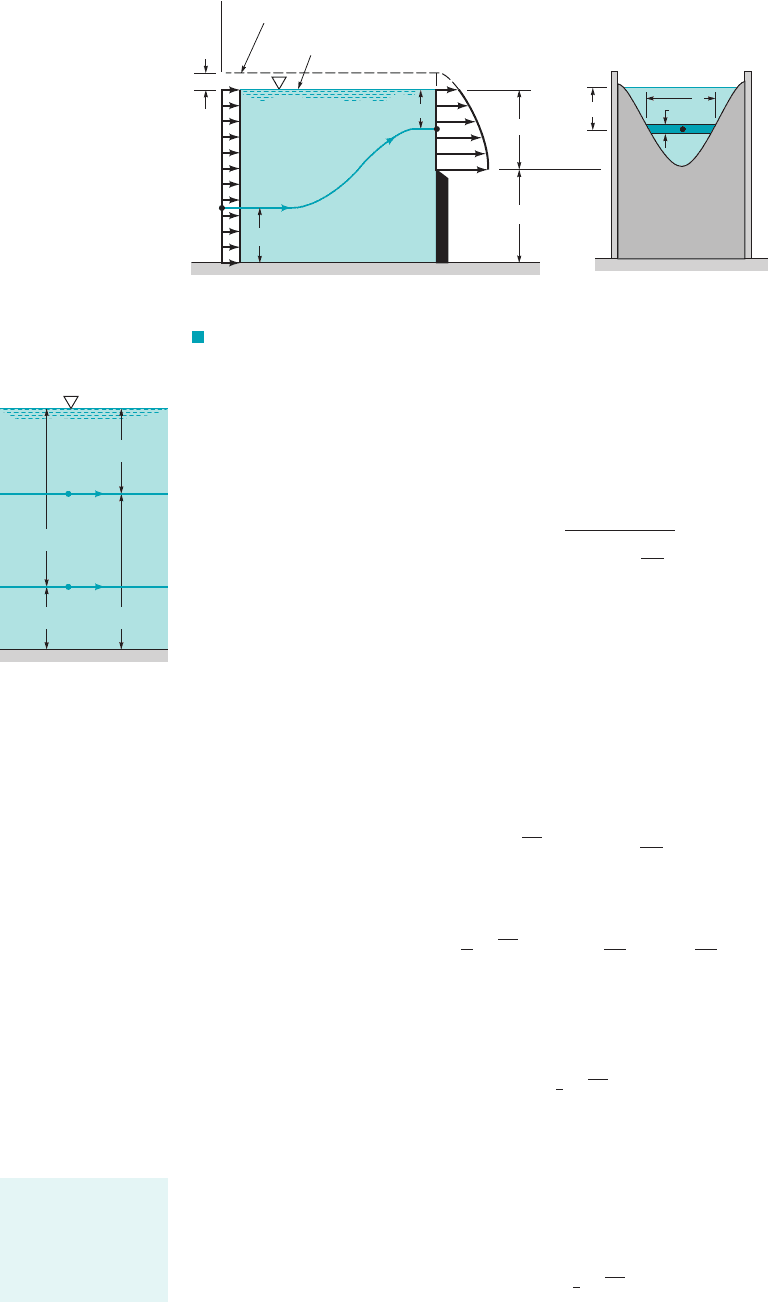
where h is the distance that point B is below the free surface. We do not know the location of point
A from which came the fluid that passes over the weir at point B. However, since the total head
for any particle along the vertical section 112is the same, H P
w
V
2
1
2g,z
A
p
A
g V
2
1
2g
562 Chapter 10 ■ Open-Channel Flow
F I G U R E 10.20 Assumed flow structure over a weir.
z
V
1
2
___
2
g
Energy line
Free surface and hydraulic grade line
h
B
V
1
z
A
A
u
2
(h)
H
P
w
x
h
B
dh
ᐉ
(b)(a)
A
p
A
/g
p
A
/g
A
V
A
V
A
Z
A
Z
A
A weir coefficient is
used to account for
nonideal conditions
excluded in the
simplified analysis.
the specific location of A 1i.e., A or A shown in the figure in the margin2is not needed, and the
velocity of the fluid over the weir plate is obtained from Eq. 10.26 as
The flowrate can be calculated from
(10.27)
where is the cross-channel width of a strip of the weir area, as is indicated in Fig. 10.20b.
For a rectangular weir is constant. For other weirs, such as triangular or circular weirs, the value
of is known as a function of h.
For a rectangular weir, and the flowrate becomes
or
(10.28)
Equation 10.28 is a rather cumbersome expression that can be simplified by using the fact that
with 1as often happens in practical situations2the upstream velocity is negligibly small.
That is, and Eq. 10.28 simplifies to the basic rectangular weir equation
(10.29)
Note that the weir head, H, is the height of the upstream free surface above the crest of the weir.
As is indicated in Fig. 10.18, because of the drawdown effect, H is not the distance of the free
surface above the weir crest as measured directly above the weir plate.
Because of the numerous approximations made to obtain Eq. 10.29, it is not unexpected that
an experimentally determined correction factor must be used to obtain the actual flowrate as a
function of weir head. Thus, the final form is
(10.30)Q C
wr
2
3
12g b H
3
2
Q
2
3
12g b H
3
2
V
2
1
2g H
P
w
H
Q
2
3
12g
b caH
V
2
1
2g
b
3
2
a
V
2
1
2g
b
3
2
d
Q 12g b
H
0
ah
V
2
1
2g
b
1
2
dh
/ b,
/
/
/ /1h2
Q
122
u
2
dA
hH
h0
u
2
/ dh
u
2
B
2g ah
V
2
1
2g
b
JWCL068_ch10_534-578.qxd 9/23/08 11:54 AM Page 562
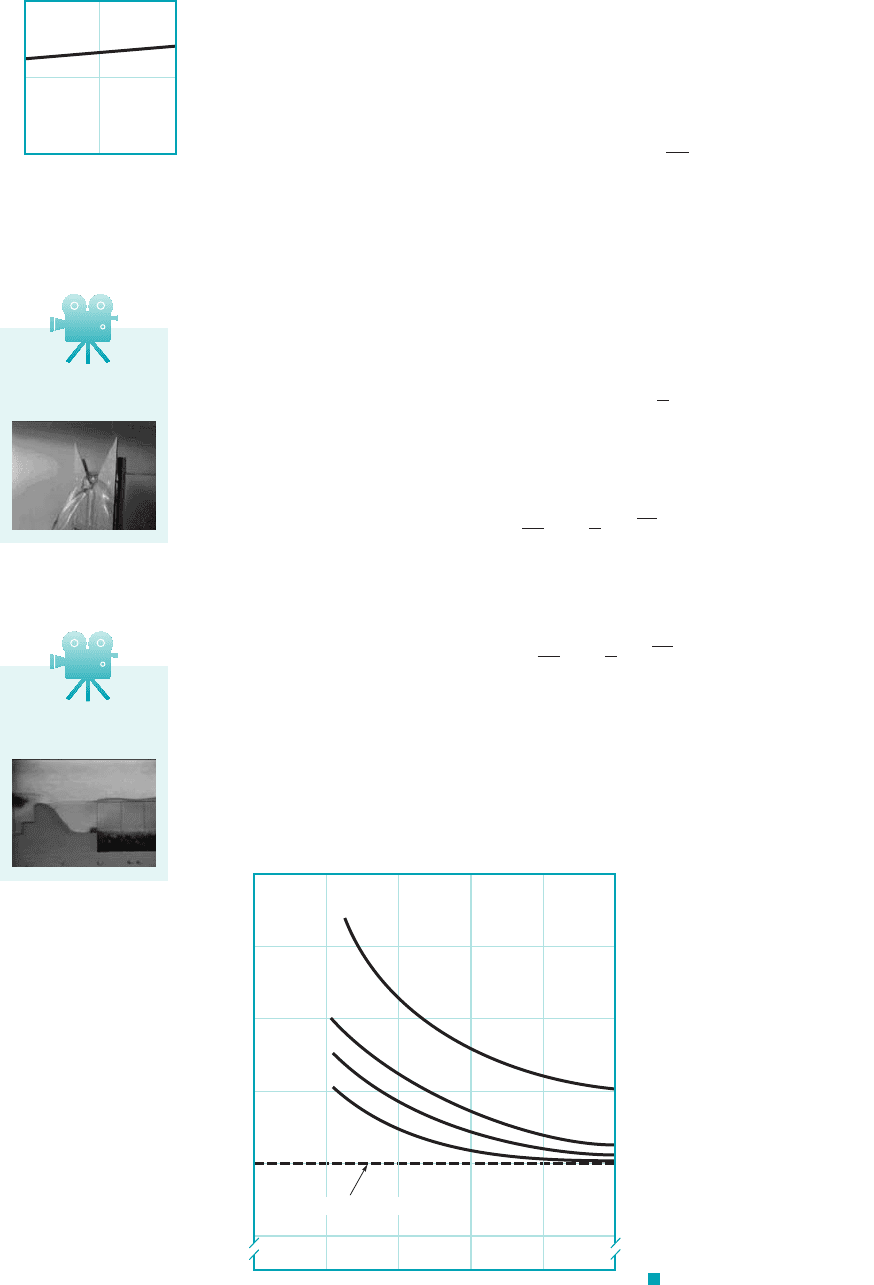
where is the rectangular weir coefficient. From dimensional analysis arguments, it is expected
that is a function of Reynolds number 1viscous effects2, Weber number 1surface tension
effects2, and 1geometry2. In most practical situations, the Reynolds and Weber number
effects are negligible, and the following correlation, shown in the figure in the margin, can be
used 1Refs. 4, 72:
(10.31)
More precise values of can be found in the literature, if needed 1Refs. 3, 142.
The triangular sharp-crested weir is often used for flow measurements, particularly for
measuring flowrates over a wide range of values. For small flowrates, the head, H, for a rectangular
weir would be very small and the flowrate could not be measured accurately. However, with the
triangular weir, the flow width decreases as H decreases so that even for small flowrates, reasonable
heads are developed. Accurate results can be obtained over a wide range of Q.
The triangular weir equation can be obtained from Eq. 10.27 by using
where is the angle of the V-notch 1see Figs. 10.19 and 10.202. After carrying out the integration
and again neglecting the upstream velocity we obtain
An experimentally determined triangular weir coefficient, is used to account for the real-world
effects neglected in the analysis so that
(10.32)
Typical values of for triangular weirs are in the range of 0.58 to 0.62, as is shown in Fig. 10.21.
Note that although and are dimensionless, the value of is given as a function of the
weir head, H, which is a dimensional quantity. Although using dimensional parameters is not
recommended 1see the dimensional analysis discussion in Chapter 72, such parameters are often
used for open-channel flow.
C
wt
uC
wt
C
wt
Q C
wt
8
15
tan a
u
2
b 12g H
5
2
C
wt
,
Q
8
15
tan a
u
2
b 12g H
5
2
1V
2
1
2g H2,
u
/ 21H h2 tan a
u
2
b
C
wr
C
wr
0.611 0.075 a
H
P
w
b
H
P
w
C
wr
C
wr
10.6 Rapidly Varied Flow 563
Minimum C
wt
for all
θ
0.66
0.64
0.62
0.60
0.58
0.56
0 0.2 0.4 0.6 0.8 1.0
H, ft
C
wt
90°
60°
45°
= 20°
θ
F I G U R E 10.21 Weir coefficient
for triangular sharp-crested weirs (Ref. 10).
1
0
01
C
wr
H/P
w
V10.13 Triangular
weir
V10.14 Low-head
dam
JWCL068_ch10_534-578.qxd 9/23/08 11:54 AM Page 563
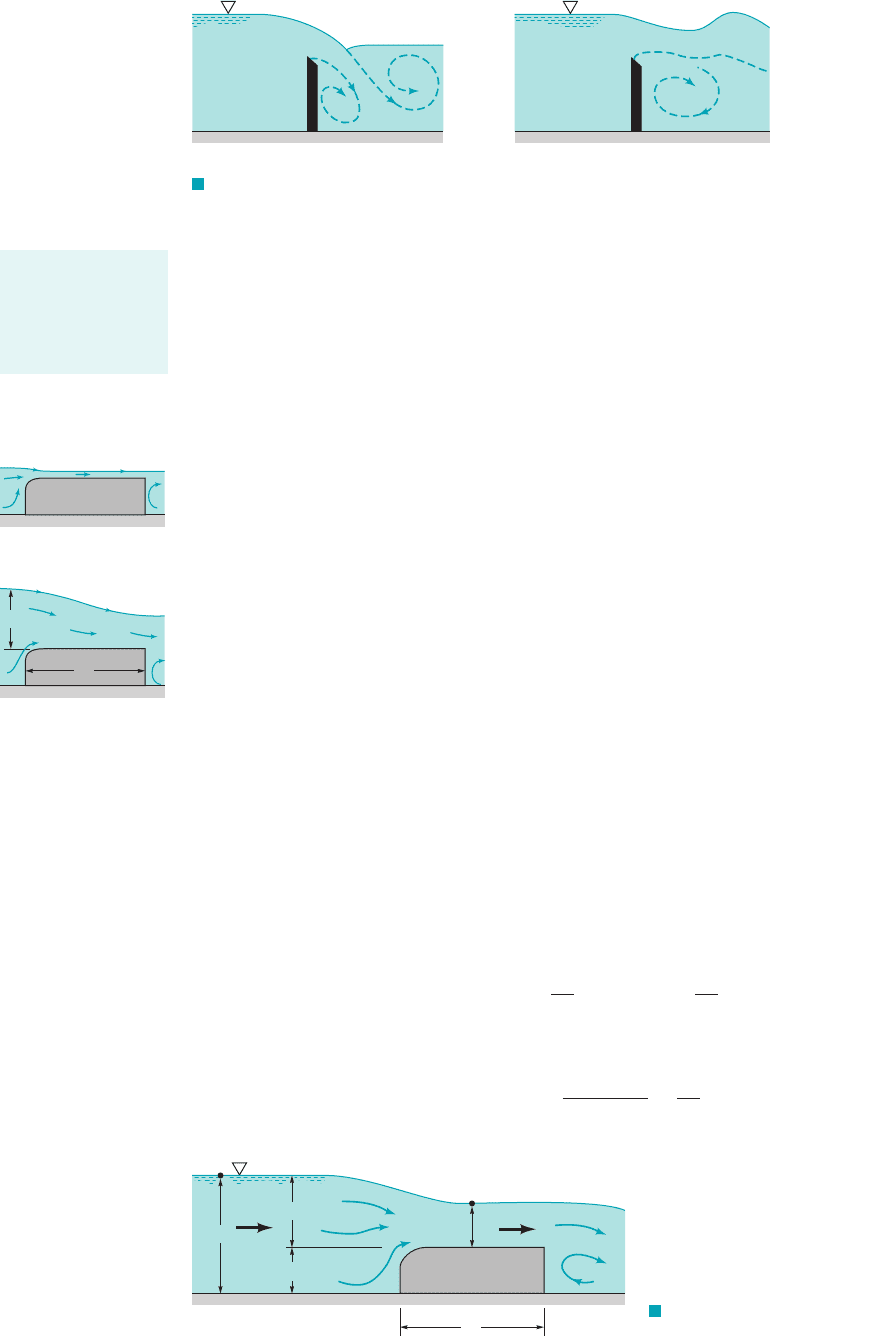
The above results for sharp-crested weirs are valid provided the area under the nappe is
ventilated to atmospheric pressure. Although this is not a problem for triangular weirs, for
rectangular weirs it is sometimes necessary to provide ventilation tubes to ensure atmospheric
pressure in this region. In addition, depending on downstream conditions, it is possible to obtain
submerged weir operation, as is indicated in Fig. 10.22. Clearly the flowrate will be different for
these situations than that given by Eqs. 10.30 and 10.32.
10.6.3 Broad-Crested Weirs
A broad-crested weir is a structure in an open channel that has a horizontal crest above which the
fluid pressure may be considered hydrostatic. A typical configuration is shown in Fig. 10.23.
Generally, to ensure proper operation, these weirs are restricted to the range
These conditions are drawn to scale in the figure in the margin. For long weir blocks 1 less
than 0.082, head losses across the weir cannot be neglected. On the other hand, for short weir blocks
1 greater than 0.502the streamlines of the flow over the weir block are not horizontal. Although
broad-crested weirs can be used in channels of any cross-sectional shape, we restrict our attention
to rectangular channels.
The operation of a broad-crested weir is based on the fact that nearly uniform critical flow
is achieved in the short reach above the weir block. 1If viscous effects are important,
and the flow is subcritical over the weir.2If the kinetic energy of the upstream flow is negligible,
then and the upstream specific energy is Observations show
that as the flow passes over the weir block, it accelerates and reaches critical conditions,
and corresponding to the nose of the specific energy curve 1see Fig. 10.72.
The flow does not accelerate to supercritical conditions To do so would require the
ability of the downstream fluid to communicate with the upstream fluid to let it know that there is
an end of the weir block. Since waves cannot propagate upstream against a critical flow, this
information cannot be transmitted. The flow remains critical, not supercritical, across the weir
block.
The Bernoulli equation can be applied between point 112upstream of the weir and point 122
over the weir where the flow is critical to obtain
or, if the upstream velocity head is negligible
H y
c
1V
2
c
V
2
1
2
2g
V
2
c
2g
H P
w
V
2
1
2g
y
c
P
w
V
2
c
2g
1Fr
2
7 12.
Fr
2
1 1i.e., V
2
c
2
2,
y
2
y
c
y
1
⬇ y
1
.E
1
V
2
1
2g V
2
1
2g y
1
H
L
w
6 0.08,
H
L
w
H
L
w
H
L
w
6 0.50.0.08 6
564 Chapter 10 ■ Open-Channel Flow
F I G U R E 10.22 Flow conditions over a weir without a free nappe: (a) plunging
nappe, (b) submerged nappe.
(a)(b)
H/L
w
= 0.08
H/L
w
= 0.50
H
L
w
F I G U R E 10.23 Broad-crested
weir geometry.
Weir block
V
1
V
2
= V
c
y
2
= y
c
L
w
P
w
H
y
1
(1)
(2)
Flowrate over a
weir depends on
whether the nappe
is free or sub-
merged.
JWCL068_ch10_534-578.qxd 9/23/08 11:54 AM Page 564
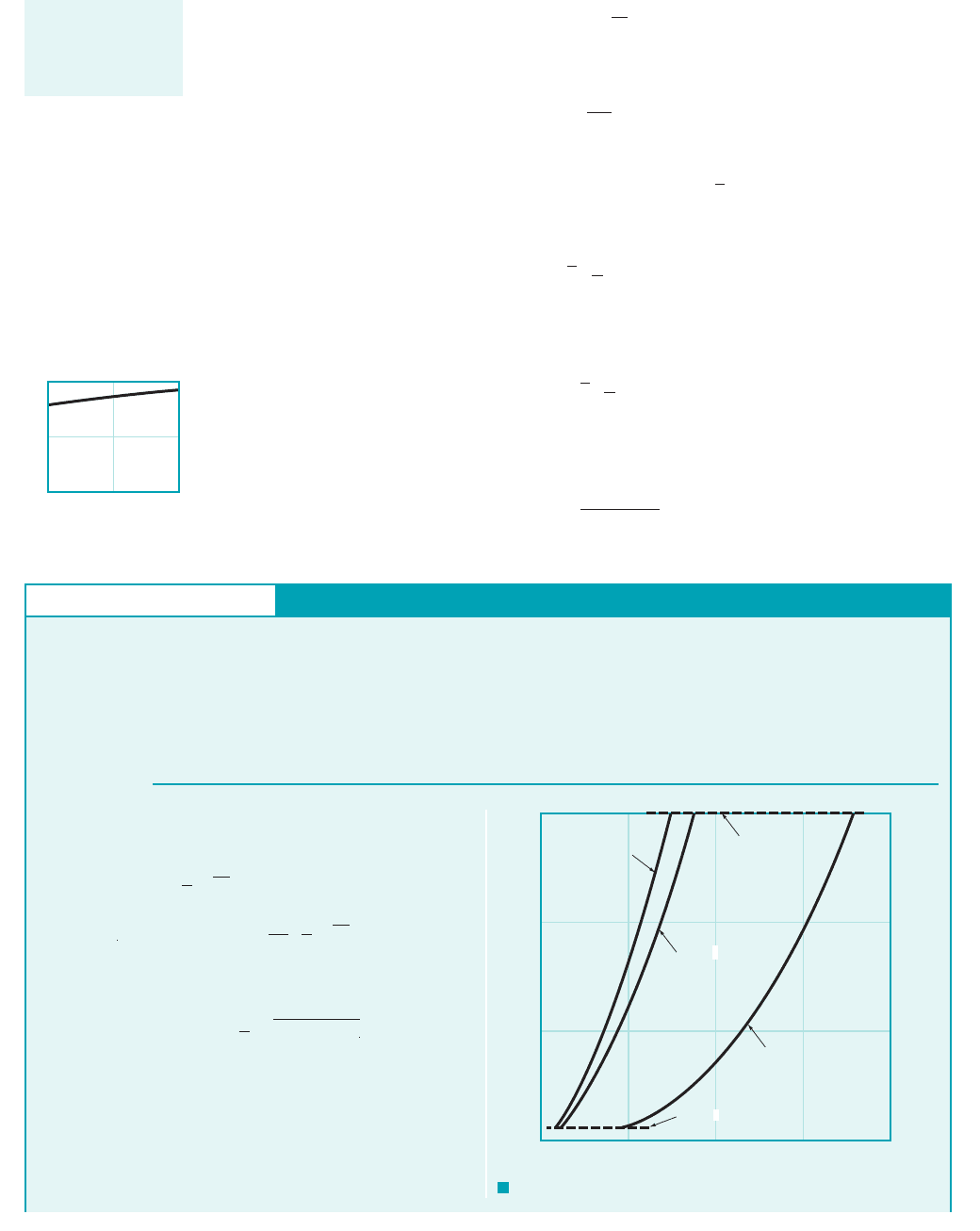
However, since we find that so that we obtain
or
Thus, the flowrate is
or
Again an empirical weir coefficient is used to account for the various real-world effects not included
in the above simplified analysis. That is
(10.33)
where approximate values of the broad-crested weir coefficient shown in the figure in the
margin, can be obtained from the equation 1Ref. 62
(10.34)C
wb
1.125 a
1 H
P
w
2 H
P
w
b
1
2
C
wb
,
Q C
wb
b 1g a
2
3
b
3
2
H
3
2
Q b 1g a
2
3
b
3
2
H
3
2
Q by
2
V
2
by
c
V
c
by
c
1gy
c
2
1
2
b 1g y
3
2
c
y
c
2H
3
H y
c
y
c
2
V
2
c
gy
c
V
2
V
c
1gy
c
2
1
2
,
10.6 Rapidly Varied Flow 565
1
0
01
C
wb
H/P
w
GIVEN Water flows in a rectangular channel of width
with flowrates between and
This flowrate is to be measured by using either 1a2a rectangular
sharp-crested weir, 1b2a triangular sharp-crested weir with
or 1c2a broad-crested weir. In all cases the bottom of theu 90°,
Q
max
0.60 m
3
s.m
3
sQ
min
0.02
b 2 m
Sharp-Crested and Broad-Crested Weirs
E
XAMPLE 10.8
flow area over the weir is a distance above the channel
bottom.
FIND Plot a graph of for each weir and comment
on which weir would be best for this application.
Q Q1H2
P
w
1 m
S
OLUTION
(a) For the rectangular weir with Eqs. 10.30 and
10.31 give
Thus,
or
(1)
where H and Q are in meters and respectively. The results
from Eq. 1 are plotted in Fig. E10.8.
m
3
s,
Q 5.9110.611 0.075H2H
3
2
Q 10.611 0.075H2
2
3
2219.81 m
s
2
2 12 m2 H
3
2
a0.611 0.075
H
P
w
b
2
3
12g bH
3
2
Q C
wr
2
3
12g
bH
3
2
P
w
1 m,
F I G U R E E10.8
0.6
0.4
0.2
0 0.2 0.4 0.80.6
0
Q, m
3
/s
H, m
Q
max
= 0.60
Triangular
Rectangular
Broad-crested
Q
min
= 0.02
The broad-crested
weir is governed by
critical flow across
the weir block.
JWCL068_ch10_534-578.qxd 9/23/08 11:55 AM Page 565

10.6.4 Underflow Gates
A variety of underflow gate structures is available for flowrate control at the crest of an overflow
spillway (as shown by the figure in the margin), or at the entrance of an irrigation canal or river
from a lake. Three types are illustrated in Fig. 10.24. Each has certain advantages and
disadvantages in terms of costs of construction, ease of use, and the like, although the basic
fluid mechanics involved are the same in all instances.
The flow under a gate is said to be free outflow when the fluid issues as a jet of supercritical
flow with a free surface open to the atmosphere as shown in Fig. 10.24. In such cases it is customary
to write this flowrate as the product of the distance, a, between the channel bottom and the bottom
of the gate times the convenient reference velocity That is,
(10.35)
where q is the flowrate per unit width. The discharge coefficient, is a function of the contraction
coefficient, and the depth ratio Typical values of the discharge coefficient for freey
1
a.C
c
y
2
a,
C
d
,
q C
d
a12gy
1
12gy
1
2
1
2
.
566 Chapter 10 ■ Open-Channel Flow
(b) Similarly, for the triangular weir, Eq. 10.32 gives
or
(2)
where H and Q are in meters and and is obtained from
Fig. 10.21. For example, with we find
or The triangular weir
results are also plotted in Fig. E10.8.
(c) For the broad-crested weir, Eqs. 10.28 and 10.29 give
Thus, with P
w
1 m
or
(3) Q 3.84 a
1 H
2 H
b
1/2
H
3/2
Q 1.125 a
1 H
2 H
b
1
2
12 m2 29.81 m
s
2
a
2
3
b
3
2
H
3
2
1.125 a
1 H
P
w
2 H
P
w
b
1
2
b1g a
2
3
b
3
2
H
3
2
Q C
wb
b1g a
2
3
b
3
2
H
3
2
Q 2.36 10.60210.202
5
2
0.0253 m
3
s.
0.60,C
wt
H 0.20 m,
C
wt
m
3
s
Q 2.36C
wt
H
5
2
C
wt
8
15
tan145°2 2219.81 m
s
2
2 H
5
2
Q C
wt
8
15
tan a
u
2
b 12g
H
5
2
where, again, H and Q are in meters and m
3
s. This result is also
plotted in Fig. E10.8.
COMMENTS Although it appears as though any of the three
weirs would work well for the upper portion of the flowrate range,
neither the rectangular nor the broad-crested weir would be very
accurate for small flowrates near Q Q
min
because of the small
head, H, at these conditions. The triangular weir, however, would
allow reasonably large values of H at the lowest flowrates. The
corresponding heads with Q Q
min
0.02 m
3
s for rectangular,
triangular, and broad-crested weirs are 0.0312, 0.182, and 0.0375 m,
respectively.
In addition, as discussed in this section, for proper operation
the broad-crested weir geometry is restricted to 0.08 HL
w
0.50, where L
w
is the weir block length. From Eq. 3 with Q
max
0.60 m
3
s, we obtain H
max
0.349. Thus, we must have L
w
H
max
0.5 0.698 m to maintain proper critical flow conditions at
the largest flowrate in the channel. However, with Q Q
min
0.02 m
3
s, we obtain H
min
0.0375 m. Thus, we must have L
w
H
min
0.08 0.469 m to ensure that frictional effects are not im-
portant. Clearly, these two constraints on the geometry of the weir
block, L
w
, are incompatible.
A broad-crested weir will not function properly under the
wide range of flowrates considered in this example. The sharp-
crested triangular weir would be the best of the three types con-
sidered, provided the channel can handle the H
max
0.719-m
head.
F I G U R E 10.24 Three variations of underflow gates: (a) vertical gate, (b) radial gate,
(c) drum gate.
(a)(b)(c)
y
1
y
2
a
(Photograph courtesy
of Pend Oreille Public
Utility District.)
V10.15 Spillway
gate
JWCL068_ch10_534-578.qxd 9/23/08 11:55 AM Page 566
